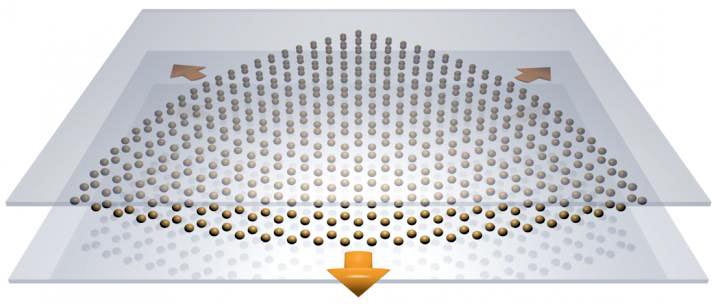Physicists “trick” photons into behaving like electrons using a “synthetic” magnetic field

Straining a honeycomb metasurface generates an artificial magnetic field for light which can be tuned by embedding the metasurface inside a cavity waveguide.
Credit: University of Exeter
Scientists have discovered an elegant way of manipulating light using a “synthetic” Lorentz force — which in nature is responsible for many fascinating phenomena including the Aurora Borealis.
A team of theoretical physicists from the University of Exeter has pioneered a new technique to create tuneable artificial magnetic fields, which enable photons to mimic the dynamics of charged particles in real magnetic fields.
The team believe the new research, published in leading journal Nature Photonics, could have important implications for future photonic devices as it provides a novel way of manipulating light below the diffraction limit.
When charged particles, like electrons, pass through a magnetic field they feel a Lorentz force due to their electric charge, which curves their trajectory around the magnetic field lines.
This Lorentz force is responsible for many fascinating phenomena, ranging from the beautiful Northern Lights, to the famous quantum-Hall effect whose discovery was awarded the Nobel Prize.
However, because photons do not carry an electric charge, they cannot be straightforwardly controlled using real magnetic fields since they do not experience a Lorentz force; a severe limitation that is dictated by the fundamental laws of physics.
The research team have shown that it is possible to create artificial magnetic fields for light by distorting honeycomb metasurfaces — ultra-thin 2D surfaces that are engineered to have structure on a scale much smaller than the wavelength of light.
The Exeter team were inspired by a remarkable discovery ten years ago, where it was shown that electrons propagating through a strained graphene membrane behave as if they were subjected to a large magnetic field.
The major drawback with this strain engineering approach is that to tune the artificial magnetic field one is required to modify the strain pattern with precision, which is extremely challenging, if not impossible, to do with photonic structures.
The Exeter physicists have proposed an elegant solution to overcome this fundamental lack of tunability.
Charlie-Ray Mann, the lead scientist and author of the study, explains: “These metasurfaces, support hybrid light-matter excitations, called polaritons, which are trapped on the metasurface.
“They are then deflected by the distortions in the metasurface in a similar way to how magnetic fields deflect charged particles.
“By exploiting the hybrid nature of the polaritons, we show that you can tune the artificial magnetic field by modifying the real electromagnetic environment surrounding the metasurface.”
For the study, the researchers embedded the metasurface between two mirrors — known as a photonic cavity — and show that one can tune the artificial magnetic field by changing only the width of the photonic cavity, thereby removing the need to modify the distortion in the metasurface.
Charlie added: “We have even demonstrated that you can switch off the artificial magnetic field entirely at a critical cavity width, without having to remove the distortion in the metasurface, something that is impossible to do in graphene or any system that emulates graphene.
“Using this mechanism you can bend the trajectory of the polaritons using a tunable Lorentz-like force and also observe Landau quantization of the polariton cyclotron orbits, in direct analogy with what happens to charged particles in real magnetic fields.
“Moreover, we have shown that you can drastically reconfigure the polariton Landau level spectrum by simply changing the cavity width.”
Dr Eros Mariani, the lead supervisor of the study, said: “Being able to emulate phenomena with photons that are usually thought to be exclusive to charged particles is fascinating from a fundamental point of view, but it could also have important implications for photonics applications.
“We’re excited to see where this discovery leads, as it poses many intriguing questions which can be explored in many different experimental platforms across the electromagnetic spectrum.”
Media Contact
All latest news from the category: Physics and Astronomy
This area deals with the fundamental laws and building blocks of nature and how they interact, the properties and the behavior of matter, and research into space and time and their structures.
innovations-report provides in-depth reports and articles on subjects such as astrophysics, laser technologies, nuclear, quantum, particle and solid-state physics, nanotechnologies, planetary research and findings (Mars, Venus) and developments related to the Hubble Telescope.
Newest articles

Recharging the Future: Batteries Built for Extreme Cold Using Negative Thermal Expansion
Most solids expand as temperatures increase and shrink as they cool. Some materials do the opposite, expanding in the cold. Lithium titanium phosphate is one such substance and could provide…

Self-Destructing Cancer Cells: Cutting-Edge RNA Breakthrough
Jülich scientists use novel RNA technology to selectively switch off tumours in the brain. An Adaptable Platform Technology That Destroys Glioblastoma Cancer Cells Using a special RNA molecule, a team…

Endurance Training: Transforming Lives of Heart Failure Patients
Can strength and endurance training be beneficial for patients with a certain form of heart failure? A research team from Greifswald investigated this question together with seven other research centers…



